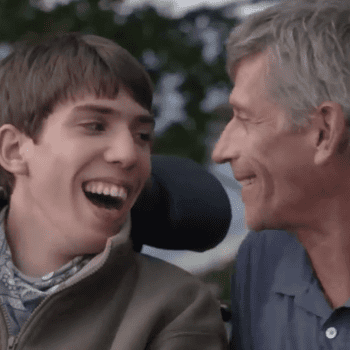
Last weekend was not a soaring opening weekend for Neil Armstrong biopic First Man. Bringing in about 16 million, it lagged behind films like Venom and A Star is Born, which are vying for portions of First Man’s already limited target audience. Some have wondered whether the film was additionally hurt by the controversy swirling around the presence of the American flag at the moon landing. (In fact, it does show the flag on the moon, but it does not show the moment when the flag is planted.) Did more conservative viewers make a snap judgment and decide to stay home en masse? Nobody can say for sure. I am inclined to blame the timing and the theatrical competition more than anything else. But having now seen the film in IMAX for myself, I can say that if conservative moviegoers are staying home, it’s their loss. In fact, I was struck by the parallels to another film that was a smash hit in that very demographic: American Sniper.
When American Sniper first came out, viewers embraced it as an authentic and respectful look at the life of a military hero. Bradley Cooper disappeared into the role of Chris Kyle, a strong man who could still be vulnerable. Cooper and Sienna Miller conveyed the fierceness of Kyle’s bond with his equally strong wife, Taya, showing how it was still stretched almost to the breaking point. While some of Eastwood’s directorial choices and artistic license indicate some doubt in the military enterprise to which Kyle was dedicated, Kyle is still allowed to speak for himself. His decisions are taken seriously, as the decisions of a flawed but serious man.
Like Chris Kyle, Neil Armstrong was also a man of few words and deep feeling beneath his stoic exterior. They were quintessential American heroes: quiet, tough, sharp, and damn good at what they did. They could hardly imagine themselves doing anything else, and neither can we. At the same time, we see that as with Kyle, Armstrong’s utter devotion to his work came at no small personal cost. Taya Kyle and Janet Armstrong are no less fully fleshed out as characters. When they fight with their husbands, their words sting, because we know they’re right. We understand why Chris Kyle keeps signing up for deployment after deployment, but we also understand Taya’s simple plea: “I need you here. We need you here.” We understand why Neil has chosen to go to the moon, but we also watch how Janet quietly struggles to raise their two boys more or less alone. The anger these women express is fueled by love and fear together: abiding love for their men, and fear that one day, these men might leave and never come home.
Death is a constant presence in both films. At one point in First Man, Janet says dryly that she and Neil have gotten “really good at funerals.” Chris and Taya Kyle could have said the same. And hovering over every funeral of a SEAL, every funeral of a NASA pilot, is the thought that it’s just fortune or providence it happened to be the other guy this time. (Kyle, of course, did die young, though in a brutal twist it was not in the war but on the home front, at the hands of an unhinged veteran.) In Neil and Janet’s case, the sting of death was even deeper than the loss of Neil’s colleagues: Their daughter had died of a brain tumor at age two before Neil joined the space program.
This loss hits the viewer early and hard in the film. The sound of her casket being lowered down is amplified and relentless, like the ticking of a clock. Fragments of memory linger and recur, like a moment when she’s fallen into exhausted sleep and Neil takes a single damp curl between his fingers. We see how Neil has filled notebooks on his daughter’s illness in heart-breakingly methodical engineer’s fashion, to no avail. Neil closes them up and packs them away after the funeral, then sits down and weeps freely with his hands folded. The way this moment was framed made me wonder if director Damien Chazelle was taking a leaf from the famous scene in It’s a Wonderful Life, where Jimmy Stewart wept real tears, and the original long shot was zoomed in to capture it.
As with the war in Iraq, the government’s choice to sink resources into the NASA project created no small amount of resentment in certain circles. To convey this tension, First Man includes a scene of black performer Gil Scott Heron whipping up a crowd with his famous chant “Whitey’s On the Moon.” Chazelle may have intended this to provide balance by showing the arguments from the other side, but for me, the way he had deeply humanized the so-called “whiteys” at the heart of the program made the chant ring hollow and bitter. Yes, I wanted to say, whitey’s on the moon. But “whiteys” suffer too. “Whiteys” lose stuff too. They lose friends and husbands and fathers, and sometimes they lose baby girls to brain tumors. Would you like to trade places with Neil Armstrong? Would you really?
Still, one could argue that this pervasive sense of sadness has an undercutting effect on the joy we would like to feel in NASA’s success. The sunk cost fallacy lurks in the background of the enterprise, as it lurks in the background of America’s military enterprises. As Armstrong says at one point in the film, when multiple things have already gone wrong and claimed lives, it’s a bit late to be asking about the price tag.
Nevertheless, we are still moved to cheer each hard-won success on the way to the moon. When he talks to the press, we listen to Neil tell us why he does what he does, and what he sees when he hovers over Earth’s atmosphere: a thin blue ribbon around a pale blue dot. A reminder that we are fragile. A reminder that we are dust.
We don’t see the moment when the flag is planted on the moon, though we do hear Armstrong’s famous words and see his first footprint in moondust as he makes his giant leap for mankind. We also thrill at a stunning IMAX shot of the lunar surface. But Armstrong’s time on the moon is framed with the same intensely personal focus as the rest of the film. In real life, nobody knows how he spent his solitary moments at Little West Crater. The film makes a guess with artistic license. It’s a choice that might not satisfy all viewers, but I found it poignant and fitting.
Like Chris Kyle’s story, Neil Armstrong’s is a story that could have been told with a political agenda. It could have been a propaganda piece, for either side of the aisle. Both films avoid both pitfalls by remembering what art is supposed to do: Tell human stories. Present characters who are complicated and let them speak for themselves. Present characters who walk into life with eyes open and shoulder what consequence it brings. Let them weep, and let them fight, and let them stumble. But let them be more than the politics around them. Let them be human. Let them be.
When Armstrong and his colleagues are placed in quarantine after their return from the moon, they see John F. Kennedy’s speech being replayed on the television: “But why, some say, the moon? Why choose this as our goal? And they may well ask why climb the highest mountain? Why, 35 years ago, fly the Atlantic? Why does Rice play Texas? We choose to go to the moon. We choose to go to the moon in this decade and do the other things, not because they are easy, but because they are hard…”
As American Sniper honors the men who chose to go to war, so First Man honors the men who chose to go to the moon. Not because their choice was easy, but because it was hard. Not because they were perfect, but because they were imperfect. Because through the imperfections of man, the spark of the divine still shines forth. It is that spark, that flame that flickers when we look up to see red, white and blue in the wind, when we look up to see moonrise in the sky. It burns in acts of courage on the battlefield when all around is chaos. It burns in the precise workings of agile minds in the silent vacuum of space. It burns in lovers silhouetted and dancing to an old record. It burns in fingers touching thin strands of golden hair for the last time. It burns with the hope that one day, we might slip the surly bonds of earth. One day, we might touch the face of God.













